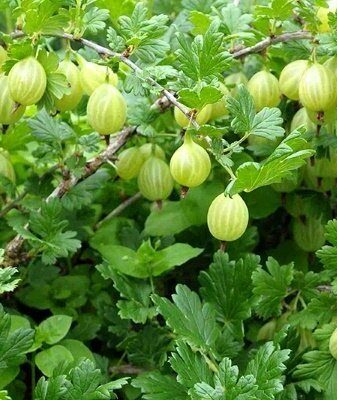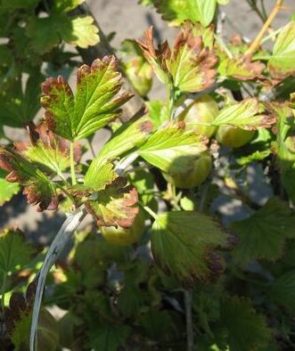Gooseberry Date: description, planting and care
Content:
Gooseberry Date: variety description
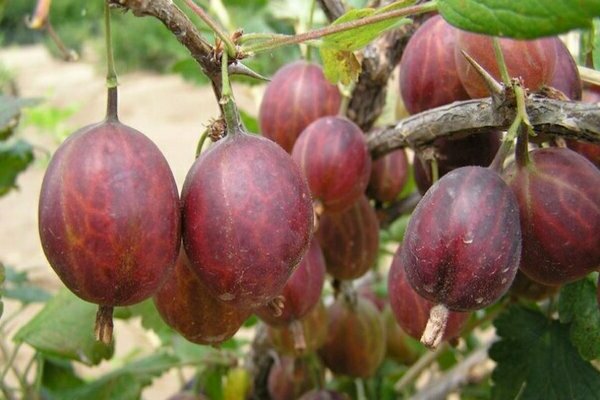
Gooseberry variety date photo
Gooseberry Date is bred by Dutch breeders. In our country, it has been cultivated since the period of Soviet power. It can grow in any region of the country.
The bush itself is quite tall and large, branches are spreading with a large number of leaves, in its height it can reach two hundred centimeters. The branches are quite powerful, strong, strong, can be arched or straight. The shoots themselves are entirely covered with small single thorns, sometimes there are double thorns. There are no thorns at the top of the shoot. For development, this species requires a large area.
The bush root system can go into the depth of the soil up to two hundred centimeters.
The leaves of the Date gooseberry variety are not too large, with a glossy shell, rich green color. They retain their color until they begin to fall off. There is a small percentage of wrinkling. There are small notches along the edges.
Ovaries of the same size, pale greenish shade with slight pubescence.
The inflorescences of plants are not large, whitish with a slight green tint, there is a slight pubescence.
The berries can be round or oval. The peel is smooth, greenish. One berry weighs fifteen to twenty grams on average. The peel itself is pretty strong, with a purple tint. Berries that grow directly under the sun will be slightly darker. The pulp inside the berry is juicy, sweet and sour. One berry contains nine percent of its sugar content, but in the rainy season, the berries will be less sweet.
Gooseberry Date: characteristic features of the variety
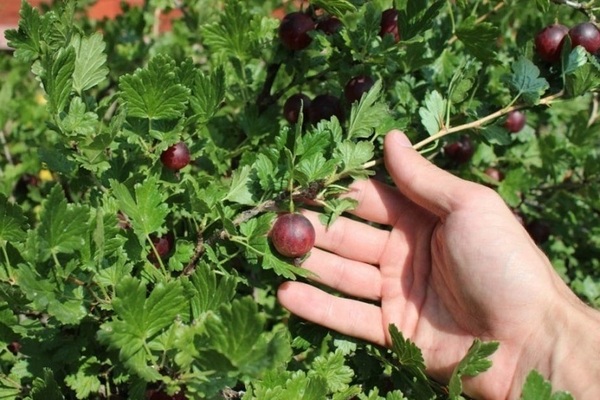
This culture belongs to late-ripening varieties. Also, it does not need pollination with the help of pollinating insects, that is, it is a self-fertile culture. For example, if you plant several such specimens, then the yield will be higher. It develops rather quickly, as well as gives young shoots. It should be borne in mind that the shrub will bear fruit only four years after planting. In the eighth to tenth year of life, the moment of the most abundant fruiting will come. The life span of a shrub of this variety is approximately twenty-five years, but those gardeners who have been growing this plant for a long time claim that the bush lives much longer.
The culture is highly resistant to frost. It can withstand the winter period at a temperature of minus thirty-five degrees. But if you live in a region with harsh winters, where the temperature reaches minus forty degrees, then the shrubs will need to provide additional shelter.
Since this shrub has a powerful root system, it can easily cope with arid conditions. But still, a prolonged period without moisture can lead to the fact that the fruits will be smaller. You also need to remember that the soil should not be waterlogged, as this can adversely affect the root system of the plant.Experienced gardeners do not recommend planting shrubs in the lowlands, as well as in all areas where groundwater is too close.
The berries of this variety ripen rather late. At about the twentieth day of the second month of the summer period - the berries begin to sing, and already at the twentieth day of the third month of the summer period - they ripen completely. It is recommended to harvest in stages, as they do not ripen at the same time. It should be remembered that on the lower branches of the shrub, the berries ripen a little later than those under the sun.
You can collect eight to ten kilograms from one bush. But if you provide him with a soil rich in trace elements, macronutrients and nutrients, then an adult specimen can bring up to twenty-five kilograms of fruit.
The berries are protected from cracking by a fairly dense skin. Therefore, they are perfect for long journeys. You can also cook from them:
- marinade;
- marshmallow;
- jelly;
- jam;
- compote.
Interestingly, even wine products are made from this gooseberry variety. If you want to preserve the berries, then they need to be picked around the end of the second month of the summer period. If you prefer to eat fresh berries, then you do not need to pick them straight away, they will not crumble for about twenty days after they are ripe. During this time, they will not lose their taste and useful properties. This variety is excellent for storage and transportation.
Disease resistance
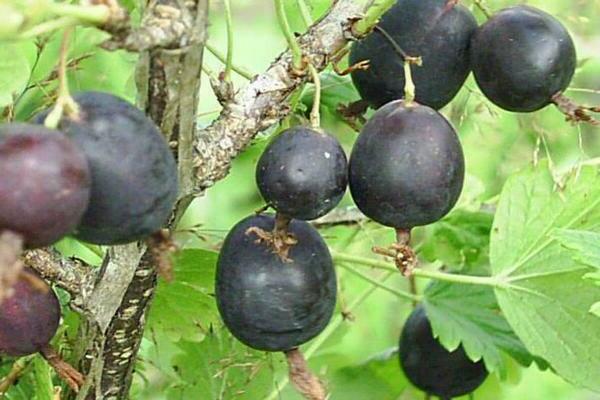
Due to the fact that it is not a hybrid variety, it is very vulnerable to powdery mildew. In order to protect the shrub from this disease, you need to select well-lit places for planting. The immune system in this species is not very high.
Resistance to insect pests in this variety is quite high.
Gooseberry Dates: Benefits
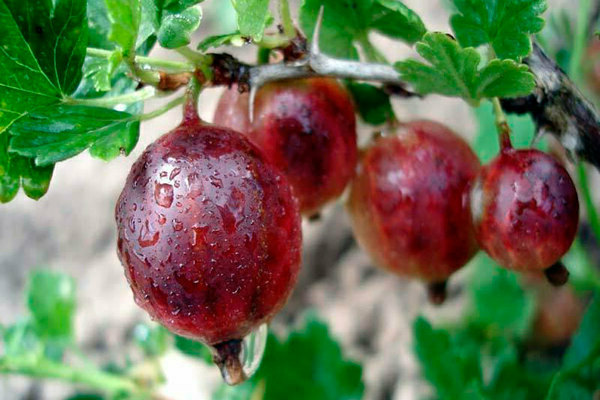
The variety has been grown for a long time and therefore there are a number of advantages.
- The shrub bears fruit for a very long time.
- The harvest is high and stable.
- This species can adapt to unfavorable weather conditions.
- Berries tolerate transportation and storage very well.
- The fruits are quite large.
- It is a self-fertile crop that does not need pollinating insects.
- This bush does not need to be transplanted, it can grow in the same place without losing its taste and useful properties.
- The berries have a sweet and sour pulp.
Disadvantages of this variety
- This variety is quite vulnerable to powdery mildew disease.
- This variety has a number of thorns, often double.
- The berries ripen late.
How to properly plant gooseberries
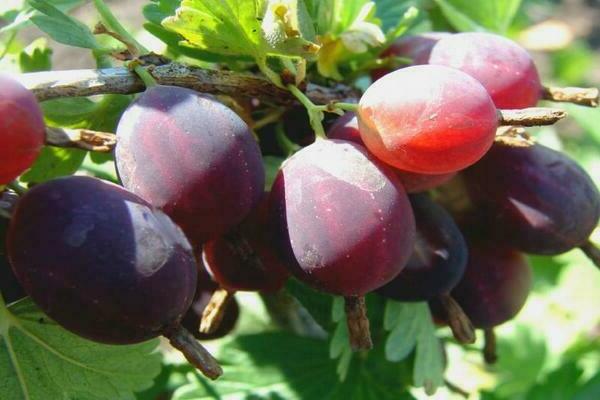
Gooseberry Date photo
It is very important to start planting literally. When recultivating gooseberries, you need to take into account some rules:
- appropriate place;
- the desired disembarkation time;
- the main rules of the process itself.
Gooseberry Date: the most suitable time for planting
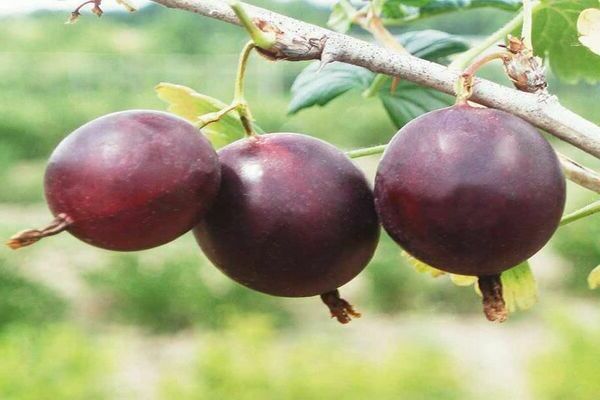
This variety is recommended to be planted in the autumn period of the year, even if the climate is temperate. More experienced gardeners recommend planting on the twentieth of the first month of the autumn period, or on the tenth of the second month of the autumn period. Young specimens of seedlings will have time to adapt, as well as start up the root system even before the cold weather. With the advent of spring, the bush will quickly grow. It is important to plant so that there are ten to fifteen days before frost. Planting in the spring should be done immediately after the soil thaws. This can be done approximately in the first month of the spring period. In the second month, spring, it will be too late. It is very important to plant a bush before sap flow begins. But it is also very important to take into account that the chance to get accustomed to the bush in the spring is much less than in the autumn.
What should be the place
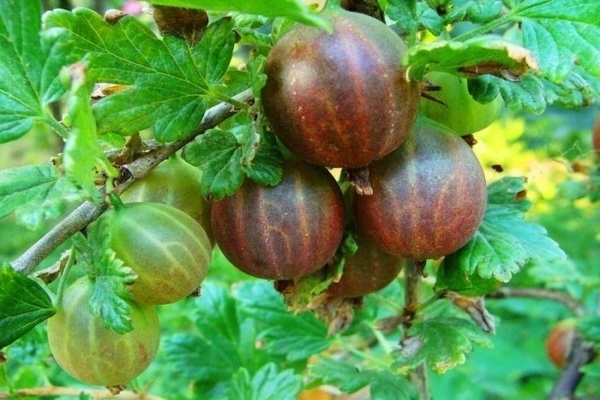
This type of gooseberry is not recommended to be planted near black currant.This will reduce the yield, reduce the size of the berries, and the bush will develop and grow worse.
The chosen location should be well lit, not shady.
You can choose a place that is blown by a windy stream. This will allow the fresh air to circulate inside the bush, which will reduce the appearance of fungal infections. Also, the soil will dry out faster after a thaw.
The acidity of the soil should be either neutral or slightly acidic. If the soil is too acidic, the berries will grow worse.
The most suitable for this variety are loamy and sandy loam soils.
In no case should you plant a bush in:
-
in the lowlands;
-
on swampy ground;
-
where the groundwater flows too close. If the soil is excessively waterlogged, the root system will begin to rot, which can adversely affect the life of the bush itself.
How to choose and stratify planting material
It is very important to know the age of the purchased planting material. The seedling should be one to two years old. The root system must be elastic, flexible. It should not be damaged, rotted, dry. The branches of the bush should be spreading. It is important to take into account that the thicker the branches on the bush, the better it will adapt to the new place. The height of the seedling should be no more than thirty centimeters. Foliage and new shoots should be absent.
Gooseberry Dates: stratification of planting material
A couple of days before the planting procedure, you need to stratify the root system of the seedling. To do this, you need to prepare a solution based on a root system stimulant. You need to place the seedling in such a solution for forty-eight hours. Also, to destroy possible bacteria and infections, potassium permanganate must be added to this solution. And a couple of hours before the planting procedure, it is recommended to process the root system with a clay talker.
How to plant
You need to prepare a landing hole forty centimeters by forty centimeters. The depth should be about sixty centimeters. Between the bushes, you need to maintain a distance of one hundred to one hundred and fifty centimeters. The seedling must be placed in the planting hole, straightening the root system.
Plants need to be placed vertically to the surface of the soil. At this point, the root system must be covered with earth. The neck of the root system should be eight to ten centimeters above ground level. The soil needs to be lightly tamped. It is necessary to water the bush with soft, settled, filtered water at room temperature. One bush will need to allocate about ten liters of liquid. The trunk circle at the trunk must be mulched. This can be done with organic humus or peat soil. The layer should be ten centimeters thick. If the gooseberries need to be pruned, about six buds should be left on them.
Gooseberry Date: the right watering regime
Watering must be timely. You need to water the bush about three times every thirty days. The soil should be wet to a depth of about forty centimeters. One bush will require forty to fifty liters of water for itself. It is very important to pay special attention to watering at the moment when the bush begins to bloom, as well as to form ovaries.
Fertilizers and feeding
In the first three years of life after planting, the bush will not require additional fertilizers and top dressing. But then, with annual digging, in the autumn period, it will be necessary to bring into the soil:
- organic humus;
- saltpeter;
- superphosphate;
- wood ash.
Ash should be of pure wood, that is, not painted, not varnished, not glued. In the summer, you can make organic fertilizing.
Pruning rules
Towards the end of the autumn period, you need to carry out sanitary pruning. That is, remove all broken, weakened, diseased, diseased, dry and non-developing shoots.This will help the bush not to waste its vitality on them. It will also provide more lush bloom in the next spring.
Wintering procedure
An adult bush does not require shelter for the winter, it can withstand cold weather. Young bushes need additional shelter. The lower part, you need to huddle, so that the earthen covering layer is ten centimeters. The top of the plant should be covered with dense material.
About possible diseases
This variety is quite vulnerable to diseases such as powdery mildew. It affects all branches, young shoots, leaf plates, as well as fruits. It prevents them from developing and makes them unfit for food.
Conclusion
Gooseberry variety Date is a great competitor to hybrid varieties. All of it is quite easy to cultivate, its fruits are large, and the yield is high. Most of all it is suitable for cultivation - the middle strip of the country. But still, it must be borne in mind that it is not quite resistant to such a dangerous disease as powdery mildew. Give the plant just a little time, and it will thank you with a stable and bountiful harvest.


